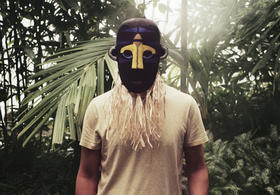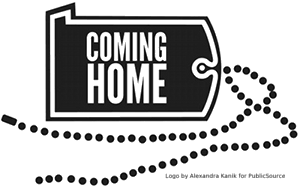
As the London-based DJ, producer and drummer SBTRKT took the stage in Seattle at the Neptune Theatre last fall, a realization filtered through the audience in discreet whispers.
"I thought he was black!"
SBTRKT, whose real name is Aaron Jerome, makes electronic dance beats in a post-dubstep mode, frequently with guest vocalists (including Little Dragon's Yukimi Nagano) singing emotionally over the top. His self-titled debut album repeatedly uses an mbira Jerome picked up on a trip to South Africa.
At play that night in Seattle was a simple misunderstanding: SBTRKT often performs with the singer Sampha, who is black, and people tend to assume singers are songs' primary artists.
But at the show in Seattle, SBTRKT also wore an African-style mask, which covered the top half of his face. And in online and print media, masks had constituted pretty much his entire public image for the past year — photos, album cover, T-shirts. Anyone who had gotten into SBTRKT's album during that period had seen the mask. Some had apparently only seen the images through his promotional feed and never Googled his face.
These days a slew of musicians from the oft-intersecting worlds of electronic music and hip-hop are tapping into the power of hiding their faces or wearing masks: SBTRKT; Shabazz Palaces; THEESatisfaction; Zomby; Odd Future's Tyler, the Creator; Flying Lotus; Burial and Deadmau5, among others. On the mainstream side, women are leaders in the same movement, with Lady Gaga and Nicki Minaj wearing masks made out of lace, hats made of raw beef and clothing resembling modern architecture.
They inhabit both male and female characters on TV and in concerts. Their precursors are Daft Punk, David Bowie, Peter Gabriel, Slipknot, Al Jolson — extreme examples of the hundreds of musicians who have altered their faces and bodies to enhance their craft, some in ways we now consider shameful. Jolson's blackface is shockingly racist by today's standards. Is SBTRKT's African mask different?
One explanation for this is that social media has made life into a big performance, with no web/life verification. Everyone can talk, but few of us can confirm the walk. We need a demarcation: life over here; performance over there. Masks signify an art zone and elevate performance to something serious, not just a fantasy that your interest in cooking makes you an Iron Chef.
At the SBTRKT show, my mind drifted to MF DOOM, the New York and Atlanta-based rapper who changed his name from Zev Love X around the turn of the millennium and started wearing a metal mask, rumored to hide heavy pain over his younger brother's death. Ten years later, with his second persona well-known in the underground and beyond, he began occasionally sending impersonators to perform his shows. They wore the mask, lip-synced the rhymes and were booed off stage.
DOOM's career traces the arc of issues that come up when performers wear masks. He started wearing it for personal reasons that were part of an art project, but then his mask became a marketing ploy (tag-board DOOM masks were distributed to audience members at his shows) and, finally, a prop to fool people. He started out as "super villain" and ended up a villain for real.
The same could be said of Zomby, the electronic DJ who might wear a mask so he won't get recognized and beat up for all the concerts he's notoriously blown off at the last minute and the large chunks of music he's been accused of stealing from other artists.
A few years ago Tyler, the Creator, of Los Angeles hip-hop/skateboarding crew Odd Future, began wearing ski masks with upside-down crosses Sharpied on them in music videos and at concerts. Through a representative, I was told he's done with masks now, forever, and does not want to speak on the subject. But while he wore them it was to great artistic effect. The ski mask highlighted how scary his underage, rapidly self-publishing crew was to the clunky music establishment, and played to his somewhat demonic character. Last year at South by Southwest in Austin, Texas, Tyler spiked his mic and stormed off early at a few shows (notably one for Billboard Magazine, which was especially punk because he was on the cover at the time) while wearing a fox mask, sending the message that all these other rappers were chickens.
For SBTRKT, DOOM and Tyler, masks ride the line between persona and gimmick. Maybe that's why Tyler's done with it. But two maskmakers, one for Seattle rap groups Shabazz Palaces and THEESatisfaction and one for Los Angeles musicians Flying Lotus and Strangeloop, attest to a strong spiritual component that sounds life-giving.
In Igbo and Edo cultures in Nigeria, masks and body suits have long been used for ritual theater performance, and likewise in American Indian, Latin American and Asian cultures. We all have a general understanding of why and how that works. Donning a second skin evaporates the ego and makes risky expression seem more safe, which is why Western psychologists have used puppets for counseling patients.
Electronic and hip-hop performers who wear masks don't particularly like to talk about it, though people who make them do. That isn't surprising, since mask-wearers are already in the habit of hiding information. But they do open up to the designers.
"We have a constant set of creative conversations," says Maikoiyo Alley-Barnes, who has made headdresses (he doesn't use the word "masks") for the Seattle rap group Shabazz Palaces.
In concert at Seattle's Moore Theatre in 2010, the musicians in Shabazz Palaces and THEESatisfaction took the stage with black, animistic superstructures on their heads.
That night the groups wore the masks and rapped each others' songs, unofficially birthing a new crew loosely referred to around town as the Black Constellation, which has since incorporated more producers and DJs. None of them likes the word "crew," but with fists aloft like Black Panthers and choreography that looked inspired by Public Enemy's military formations, Shabazz Palaces and THEESatisfaction connected in a powerful way at the Moore. Alley-Barnes said he could feel it in the back row of the traditional theater. "There was definitely a weight," he says.
Shabazz emcee and producer Palaceer Lazaro (a pseudonym for Ishmael Butler) says he also felt a weight. In an email, he writes that he didn't wear the mask so much as it wore him. He calls the performance, "a diluting of the individual into a concentrated 'us.'"
Alley-Barnes considers himself part of a guild of makers that goes back thousands of years, a belief parallelled by a THEESatisfaction lyric about "being an extension of the best," and jibing with the Palaceer's idea of individuals on stage subsumed into something greater. Alley-Barnes, who has also directed and art directed music videos for Shabazz, says all the collaboration isn't a new thing but an old thing, happening in a cycle: "I'm a derivative of a very old people, and some of us are finding each other again."
He says his masks — which he made out of trash and recycling, and formed with his hands — were made in a trance state.
"The thing I'm talking about predates language. It's primal. Language is old, but not primal. You ask me where these shapes come from, and of course traditional Africa, traditional Asia. But it's not a conscious enough process for me to intellectualize it."
Leigh McCloskey, a Los Angeles-based artist and actor (he was Mitch Cooper in Dallas) who has made masks worn by DJ and producer Flying Lotus, brings up the same idea of being unconscious on purpose on the phone from Malibu. He's still blown away that Flying Lotus (Steven Ellison) wanted his photo taken wearing a mask in front of "Ascension," a McCloskey painting about "music beyond notes."
Two photos were taken of Flying Lotus wearing masks and used for promotional images that circulated for Flying Lotus' 2010 album Cosmogramma. One was shot outdoors in McCloskey's yard. The other, in front of "Ascension," in his studio.
"My studio's called the Heiroglyph of the Human Soul," says McCloskey. "It's actually a 3-D painted library, studio and wonder study."
"We both like to work with improvisation and see where that takes us," McCloskey says of the similarities between his work and Ellison's. "With the masks, it was about seeing what the alchemy of different elements would create. I don't think there was an underlying, deep, 'We have to achieve this.'"
Inside the studio are original copies of McCloskey's hand-drawn and hand-painted tome Codex Tor, which Flying Lotus excerpted for his striking Cosmogramma album art. The art features lots of circles and intricate lines, matching Flying Lotus' throbbing, more-is-more music, which combines electronic patchwork, instrumental hip-hop, jazz and funk. After styling the Cosmogramma artwork and making the masks, McCloskey appeared on stage at the album release party in Los Angeles and painted live on canvas and glass.
"It was a very interesting effect," he says, "that primal gesture of the paint hitting the glass or the canvas, and [Flying Lotus and friends] doing fascinating feedbacks and loops."
McCloskey met Flying Lotus eight years ago, when his 24-year-old daughter introduced them. He's known Dave Wexler — a visual artist and musician, known as Strangeloop — since Wexler was in high school. He's aware of his deep influence on their artworks, and feels good about that, a little like, as he says, "Socrates corrupting the youth of Athens."
"When people come to my studio, I say, "We're returning to the cave,'" he says. "When I look at what we can do technologically — and what I love about Dave and Steve and their whole generation — is this relation of the creative extension through machines, of all these different voices. I feel it's a nice juxtaposition and a stabilizing element, me painting in this ancient way and then to go full circle to what is happening in the other direction, and that it's all happening on the same stage is good for the human psyche. It's like, 'Oh yeah, we're not going somewhere else, we're actually creating greater and greater synthesis.'"
One idea McCloskey returns to in conversation is the value of collaboration, how sharing inspiration is vital to the evolution of ideas. Alley-Barnes kept saying the same things: we are not alone in this world, no man is an island, time isn't real. They don't know each other, but in interviews both artists used the same words to talk about what they made: alchemy, primal, Africa, Asia, anti-intellectual, incantation. They both take the long view and work with the musicians not as contracted employees, but as members of a society that might convene at any time.
That's what masks are about, and what music is about, too. Language beyond language, using emotions and sensations to communicate in some realm that exists simultaneously with our everyday experience, a place where life and death go in waves and everything is everything. Masks tell big stories that might have us believe we traveled somewhere else, or received a supernatural message.
In the new video Alley-Barnes directed for Shabazz Palaces' "Are you … Can you … Were you? (Felt)," wall-mounted masks hang in a residential home and oversee a classic conflict between mother and daughter. Their presence makes the argument an incantation, a story that echoes in opposite directions on the timeline, forever. Masks have also cropped up in a half-dozen other Seattle hip-hop and punk rock videos recently, maybe because they're cheap special effects. Everyone who uses them experiments with different levels of seriousness and degrees of commitment. For the artist and the audience, they can be powerful, connective, transportive — or just cool to look at.
This video contains a few instances of profanity and illustrations that feature semi-abstract nudity.
Copyright 2012 National Public Radio. To see more, visit http://www.npr.org/.





